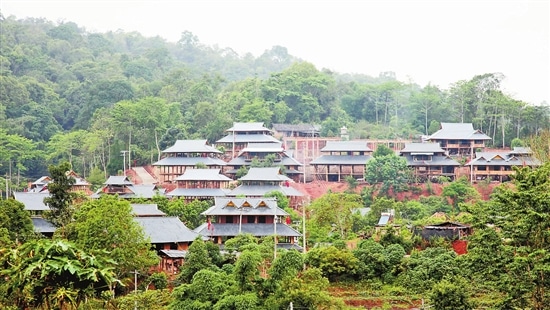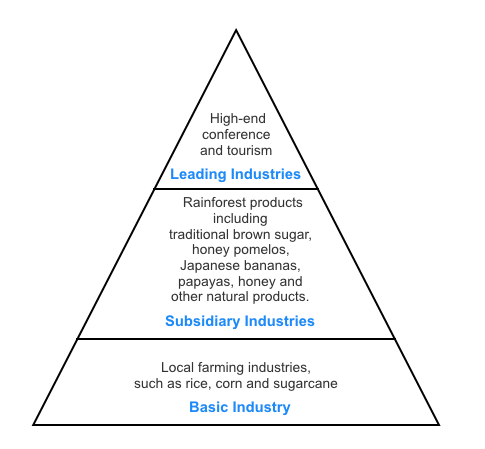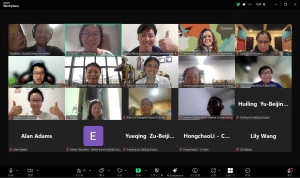Editor’s Note
This article was originally published by the China Philanthropy Times(公益时报)on the 26th of August 2017. It describes a poverty alleviation project led by Professor Li Xiaoyun in a village in Southern Yunnan province, near the border with Laos. Below is CDB’s translation.

In 2011 the Chinese government drew up a program to eradicate poverty lasting until 2020. This program must count as the most determined action taken since the state started promoting poverty alleviation, and the one with the highest amount of resources invested in it. Its strength is unprecedented. The comprehensive effort to manage the deep poverty in Hebian village is a successful case of effective poverty alleviation supported by China’s charity sector, which displays certain unique characteristics.
Li Xiaoyun, a professor from China Agricultural University, has researched poverty alleviation for more than 20 years and set up the “Xiaoyun Poverty Alleviation Centre” in Hebian village (literally “Riverside Village”), Mengla County, Xishuangbanna Dai Autonomous Prefecture, Yunnan Province, creating a model of cooperation between the charity sector and the government. This model has been extensively propagated and studied.
So what kind of background is there to the successes that have been achieved by the Xiaoyun Poverty Alleviation Centre? What influences have come out of the project’s methods and production? Does this method have the potential to be reproduced? And what kind of plans are there for the future? In order to answer these questions, the China Philanthropy Times carried out a special interview with the founder of the Xiaoyun Donation Centre, and listened to his and Hebian village’s story.
Why carry out the Hebian Village project?
In March 2015, the Xiaoyun Poverty Alleviation Center established a presence in Hebian Village, a village of the Yao ethnic minority in Mengla County, Yunnan Province. Within two short years, the Hebian Village Project had already received approval from the Yunnan Provincial government, and was being promoted throughout the whole province.
From Li Xiaoyun’s point of view, if public welfare organisations want to become a pro-active force in China’s political and social transformation, they must define how they will set up a more pro-active relationship with the government, and this relationship must be based on two preconditions; the first one is guaranteeing the stability of China’s politics and society, without creating divisions or inconveniences, and the other one is ensuring that resources are used in a complementary and effective fashion while building up this relationship, avoiding waste.
As Li Xiaoyun emphasises, “the government and the public welfare organisations must sufficiently complement each other and improve efficiency in their use of resources for development and for resolving social problems. This complementary relationship depends on NGOs sufficiently demonstrating an original purpose. We must make the purpose and positioning of public welfare organisations unshakeable and indispensable. So looking back, has today’s public welfare sector reached this point? There’s still a long way to go.”
As one of the first researchers studying poverty alleviation, Li Xiaoyun feels that capital, ideas and government leadership and planning are never lacking in poverty alleviation projects. Only the issue of walking the ‘last mile’ and reaching the poor remains unsolved.
According to Li Xiaoyun, poverty alleviation is a very scientific and serious work that requires high technical abilities, but non-profit organizations should not stop exploring and learning, because that is their mission. As an academic studying poverty alleviation, he wanted to do an experiment – to see how non-profit organizations can meet the needs of both governments and ordinary people in solving the ‘last mile’ problem, and spend the money that the government has put into the problem both professionally and effectively.
Li Xiaoyun once visited Mengla County in the 1990s, and at the time it left him with quite a good impression. Two years ago, when he returned to Mengla County to do poverty alleviation research in Hebian village, he was deeply touched by the situation in the village. Since none of the houses could be defined as decent, the village children had to walk and play barefoot on the cold floor during winter. The farmers’ living quarters were scattered, transportation was extremely inconvenient, manufacturing and standards of living were backward, social development was low, poverty ran deep, the ability to self-develop was weak, and the subjective push to break out of poverty was insufficient.
Why not sink in, leverage his own academic achievements and partner with the party committee, government and local villagers to explore and develop a recipe for the economic development of Hebian village? Thus he decided to stay and begin his intricate ‘last mile’ poverty alleviation experiment there.
Mengla County is situated in the southernmost part of Yunnan Province, sharing a border with Laos. Under the jurisdiction of Hebian is a natural village of the Landianyao ethnic group, right next to the rainforest, where every sugar cane season wild elephants would come to eat the crops, sometimes even breaking into the villages. As transportation is very inconvenient, Hebian village can be said to have the worst conditions out of the whole Mengla County.
Because traffic and road conditions were so poor, villagers would be effectively trapped at home whenever it rained. Additionally, many households in the village also shouldered debt. Through research, Li Xiaoyun found that from 2014 to 2015 the yearly average household income in Hebian village was 13,277 Yuan and per capita income was 3,193 Yuan, much lower than the average per capita income for China’s rural residents in 2014, which was 10,489 Yuan, and lower than the average for Yunnan province in 2014, which was 7,456 Yuan.
Therefore, the original intention of Li Xiaoyun’s experiment was to find out how to solve the kind of structural poverty that plagued Hebian village.
A strategy for development and prosperity in Hebian village
In March 2015, Action Against Poverty (AAP, 小云助贫中心) was registered with the Mengla County Civil Affairs Bureau. Various departments within Mengla County gave the organization enormous support during the registration process. The County Poverty Alleviation Business department and the County Registration Management department within the Civil Affairs Bureau helped Action Against Poverty to obtain legal status.
According to Li Xiaoyun, Action Against Poverty currently only has three permanent members of staff, in other words a full-time project officer, a driver also acting as a project officer, and an accountant. The centre’s projects are implemented through the mobilization and recruitment of various kinds of professional volunteers. These volunteers include Li Xiaoyun’s colleagues and students, and professional volunteers recruited externally, such as architects.
“If the income of those in deep poverty is raised by 20% (and farmers’ income nationally grows at an annual rate of 9-10%), at this rate the farmers will never escape poverty. We thus proposed that if Hebian village is to escape the low income trap, incomes must increase by at least 100%”, as Li Xiaoyun concluded after careful calculations. Based on this conclusion, he proposed that Hebian village should develop a compound industry.
“We analysed the local characteristics, for example the natural resources and climate, and we finally decided to take advantage of the local climate (which allows you to avoid the freezing cold in winter and the oppressive heat in summer). At the same time, the local rainforests are home to Asian elephants and other natural resources and tourist attractions; there is also the Yao people’s own minority culture. We can turn Hebian village into a small scale conference village, used mainly for meetings and training, but also for leisure, tourism, parent and child activities and so on, and create a leading industry. Following this lead we created our own public welfare product, called the Yao Mama Guesthouse” Li Xiaoyun explains.
Li Xiaoyun structured the model of the Hebian village project on the following basis: first of all, develop the leading industries. Hebian village itself has many strengths, such as a full range of natural climate advantages, the tropical rainforest landscape, and the nearby tourist attraction of the Parashorea tree scenic area. Based on these strengths, Li Xiaoyun plans to turn Hebian village into a high-end conference and economic tourism town. Once the houses are built, future tourists and people who come to attend meetings can stay at the Yao family guesthouses, living alongside the local people and experiencing ‘full immersion’ in the local culture. Such a set up would increase the farmers’ income substantially. This is the leading industry in Li Xiaoyun’s blueprint for poverty alleviation.
Secondly, develop subsidiary industries. Action Against Poverty created the Hebian village brand of “Natural Rainforest Eggs” and targeted high-end consumer groups in Beijing, Shanghai and other big cities through an online business platform. Supplied directly to Shanghai, Beijing and other places, these “Natural Rainforest Eggs” can be sold for 10RMB a piece, bringing in a considerable income for the villagers. According to Li Xiaoyun, future products for potential distribution include traditional brown sugar, honey pomelos, Japanese bananas, papayas, honey and other natural products. At the same time, the farming of winter vegetables will also be developed to increase the diversity of the subsidiary industry.
Thirdly, develop the basic industry; that is, the existing local farming industries, such as rice, corn and sugarcane.
Hebian Village Development Model

“Adding up these three levels, the income of the farmers is no longer limited like it used to be”, says Li Xiaoyun. He added that without resolving the problem of income growth, they could only keep going round in circles, stuck in the poverty trap.
“We plan to spend three years on the construction of a residential system based on the principles of ecological health and economic sustainability. The system will help the villagers break free from the costs imposed by housing and the environment. We will complete the basic construction of the infrastructure and public service facilities in the village, so that they are no longer an obstacle on the path to improving the quality of life of the villagers. We will build a high-output, market-oriented, advanced system of ecological manufacturing, so as to get rid of the village’s dependence on the rainforest’s natural resources, the environmental destruction and the state of perennial low income. We will develop a public welfare model of rural governance which everyone can participate in, and change the backwards situation of service and governance in areas of rural poverty”, says Li Xiaoyun.
Integrating Resources from the Government and the Public Welfare Sector
Putting a plan to action requires funding support. By collaborating with government and public welfare forces, the AAP has found a path towards a common effort for development.
The government supplied more than 10,000,000 Yuan for the construction of housing and infrastructure. In order to decrease the farmers’ debts, the AAP sought public funding for construction in Hebian village and the building of the Yao Mama Guesthouse through Tencent’s “9/9 Charity Day”. In 2015 and 2016, it raised more than 1,100,000 and 600,000 Yuan respectively. With the support of the AIDE Foundation and the China Women’s Development Foundation, a public organization was established to supervise the use of donations throughout the project.
Through this mechanism, the AAP also attracted donations from the China Merchants Foundation and the Australian Embassy. The donations raised through the “9/9 Charity Day” and other charitable organizations totalled more than 3 million Yuan, mainly used to subsidize the village’s landscaping, model housing, model room construction, and the Yao Mama Guesthouse’s interior decorating.
“Funds from the “9/9 Charity Day” will be used to subsidize farmers’ housing. Each household will get more than 20,000 Yuan for windows, bedding, lighting and extras. If there was no government investment in the construction of housing and infrastructure, it would be impossible to build the Yao Mama Guesthouse. This shows that public resources must be used in the most technical areas, and cannot fully replace government resources”, Li Xiaoyun sums up.
“The most crucial aspects are innovation and professionalism. Our working methods are meant to complement the government’s work under their leadership, and to create a uniquely irreplaceable role for public welfare organizations by making up for what’s lacking. With the help of government-led projects, charitable organizations can establish their own unique role in society so that all can see their value. Once you have made obvious achievements, society cannot deny your value”, he stresses.
The government and nonprofits have achieved a good collaboration through this method. This combined effort, however, also presents a big challenge.
“Action Against Poverty has implemented really modern concepts in a really traditional and underdeveloped village. However, there exists a considerable gap in the areas of management and marketization. The local farmers aren’t able to keep up, nor are they able to organize these things themselves. This has become the next focal point of our work: how can we work with the farmers to establish a set of relationships and mechanisms that will allow us to carry out our work.”
According to Li Xiaoyun, the local problems they have encountered are not only deep but unlike what other charitable organizations face. “First of all, how does a charitable organization take the advanced, modern concepts it has brought to a village and indigenize them? That’s a big challenge. At the moment we don’t have any better way of tackling this problem, and because we’re still searching for an answer, we’ve decided to slow down.
Secondly, after charitable organizations are able to find an innovative way to reach the second stage, it is incredibly difficult to determine how to help the farmers engage in innovation and get connected with the market. Currently the standard method has been to connect companies with household farms, but sometimes this isn’t exactly an ideal solution. So at the moment, our work has really come up against a bottleneck within the charitable sector, and our administrative and innovative capacities are lacking. The current problems are that farmers continue to rely on Action Against Poverty, while the outside world doesn’t correctly understand the needs or strengths of the local people.”
Referring to Action Against Poverty’s plans for the future, Li Xiaoyun says “Action Against Poverty plans to work with the UNDP and the Yunnan branch of the All China Women’s Federation, as well as the UNDP and the Hainan Provincial Government, to set up project areas in the cities of Chuxiong in Yunnan Province and Wuzhishan in Hainan Province, respectively. In Enshi County, Hubei Province, we will provide charity project support for a poverty alleviation district created by the Xinhu Group. This shows that our project model can be replicated.”
“What we want to do now is determine how to link up farmers with the market and how to market their products. At present, since our local projects can’t operate independently of Action Against Poverty, and the local government doesn’t have the ability to take them over, we plan to possibly operate through a social enterprise model.”



